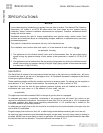
SPECIFICATIONS MODEL 300 RESTAURANT RANGES
ONS
VENTILATION
SPECIFICATI
! WARNING
Improper ventilation can result in personal injury or death. Ventilation which fails to properly remove
flue products can cause headaches, drowsiness, nausea, or could result in death.
All units must be installed in such a manner that the flow of combustion and ventilation air are not
obstructed. Provisions for adequate air supply must be provided. Do not obstruct the front of the unit
at the top by the control panel, or the bottom just below the oven compartment, as combustion air
enters through these areas.
NOTICE
Proper ventilation is the owner’s responsibility. Any problem due to improper ventilation will not be
covered by the warranty.
All units must be installed in such a manner that the flow of combustion and ventilation air are not
obstructed. Provisions for an adequate air supply must be provided. Do not obstruct the front or rear
of the unit, as combustion air enters through this area. Be sure to inspect and clean the ventilation
system according to the ventilation equipment manufacturer’s instructions.
Ranges with solid tops, such as griddles or hot tops, must always have venting for their flue products at the
rear of their burner compartments provided by the hollow area inside a shelf 21" high or a backsplash 17"
high. Lack of sufficient venting for the burners in these compartments will cause poor burner and pilot
operating characteristics, resulting in inefficient performance. Such conditions also cause high ambient
temperatures at the manifold area and create valve and thermostat problems.
Canopies are set over ranges, ovens, etc., for ventilation purposes. It is recommended that a canopy extend
6" past the appliance and the bottom edge be located 6'6" from the floor. Filters should be installed at an
angle of 45° or more from the horizontal. This position prevents dripping grease and facilitates collecting the
run-off grease in a drip pan, unusually installed with a filter. A strong exhaust fan tends to create a vacuum in
the room and may interfere with burner performance or may extinguish pilot flames. Fresh air openings
approximately equal to the fan area will relieve such a vacuum.
The exhaust fan should be installed at least 2" above the vent opening at the top of the unit.
If the unit is connected directly to an outside flue, a CSA design certified down draft diverter must be installed
at the flue outlet of the oven and connected to the flue.
In case of unsatisfactory performance on any appliance, check the appliance with the exhaust fan in the
“OFF” position. Do this only long enough to check equipment performance. Then turn hood back on and let it
run to remove any exhaust that may have accumulated during the test.
ELECTRICITY SUPPLY
Units with a convection oven require connection to a supply of electricity. The appliance, when installed,
must be electrically grounded in accordance with local codes, or in the absence of local codes, with the
National Electrical Code, ANSI/NFPA 70, or the Canadian Electrical Code, CSA C22.2, as applicable. An
electrical diagram is located on the rear of the range, near the motor.
Usually the range is furnished with one or two power cords (one for each oven), each with a standard 115V
60Hz single-phase prong plug. Total maximum amps for 115V units is 12.5.
The range can be ordered to operate on 208V 60Hz 1-phase or 3-phase current, in which case the electric
power supply must be wired to one or two junction boxes (one for each oven), each with a terminal block on
the rear of the range. Total maximum amps for 208V units is 8.1.
PAGE 8 OPERATOR’S MANUAL 1182298 REV 3


















